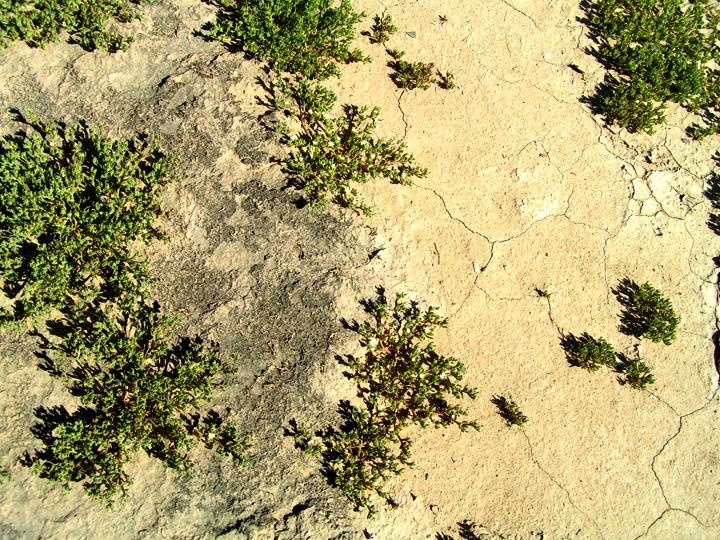Researchers find microbial heat islands in the desert

The desert outside Chandler, Ariz., shows a darkening of the biocrust (left) over its surface. Credit: Ferran Garcia-Pichel, Arizona State University
New research from Arizona State University now reveals how microbes can significantly warm the desert surface by darkening it, much in the same way that dark clothes will make you feel warmer in sunlight. These desert-darkening organisms make a living basking in the sun and form a mantle that covers the landscape.
Such mantles, called biological soil crusts, or biocrusts, provide important ecosystem services, like fighting erosion and preventing dust storms, or fertilizing the ground with carbon and nitrogen.
The new ASU research shows how the biocrust microorganisms, in an effort to protect themselves from harmful ultraviolet rays in the strong desert sun, produce and lay down so much sunscreen as to noticeably darken the soil, changing the reflectivity of the desert surface as they spread across the land.
The research is outlined in the article “Bacteria increase arid-land soil surface temperature through the production of sunscreens,” published in the Jan. 20, 2016 issue of Nature Communications. It was written by Estelle Couradeau, a Marie Curie postdoctoral fellow at Arizona State University, and Ferran Garcia-Pichel, an ASU professor and Dean of Natural Sciences in the College of Liberal Arts and Sciences.
It is part of a long-term institutional collaboration with Lawrence Berkeley National Laboratory, whose fellow scientists Trent Northen, Ulas Karaoz, Hsiaon Chiem Lin, Ulisses Nunes da Rocha and Eoin Brodie, are co-authors of the paper.
“We have found that the presence of sunscreen-bearing crusts can actually raise local surface temperature by as much as 10 degrees C (18 degrees F). Because globally they cover some 20 percent of Earth's continents, biocrusts, their microbes and sunscreens must be important players in global heat budgets,” said Couradeau.
“We estimate that there must be some 15 million metric tons of this one microbial sunscreen compound, called scytonemin, warming desert soils worldwide,” added Couradeau, the lead author of the paper.
Couradeau spent the last three years studying biocrusts in the laboratory of Garcia-Pichel.
“An increase of 18 degrees F is not without consequence, and we can show that the darkening of the crust brings about important modifications in the soil microbiome, the community of microorganisms in the soil, allowing warm-loving types to do better,” Garcia-Pichel added.
“This warming effect is likely to speed up soil chemical and biological reactions, and can make a big difference between being frozen or not when it gets cold,” he explained. “On the other hand, it may put local organisms at increased risk when it is already quite hot.”
Couradeau and Garcia-Pichel said that while biocrusts have been overlooked in the past they are now getting much closer scrutiny from scientists.
“Biocrusts, while cryptic, deserve more consideration from us,” concluded Couradeau. “We need to include them in our climate models and speak about them in the classroom.”
Media Contact
All latest news from the category: Earth Sciences
Earth Sciences (also referred to as Geosciences), which deals with basic issues surrounding our planet, plays a vital role in the area of energy and raw materials supply.
Earth Sciences comprises subjects such as geology, geography, geological informatics, paleontology, mineralogy, petrography, crystallography, geophysics, geodesy, glaciology, cartography, photogrammetry, meteorology and seismology, early-warning systems, earthquake research and polar research.
Newest articles

First-of-its-kind study uses remote sensing to monitor plastic debris in rivers and lakes
Remote sensing creates a cost-effective solution to monitoring plastic pollution. A first-of-its-kind study from researchers at the University of Minnesota Twin Cities shows how remote sensing can help monitor and…

Laser-based artificial neuron mimics nerve cell functions at lightning speed
With a processing speed a billion times faster than nature, chip-based laser neuron could help advance AI tasks such as pattern recognition and sequence prediction. Researchers have developed a laser-based…

Optimising the processing of plastic waste
Just one look in the yellow bin reveals a colourful jumble of different types of plastic. However, the purer and more uniform plastic waste is, the easier it is to…



